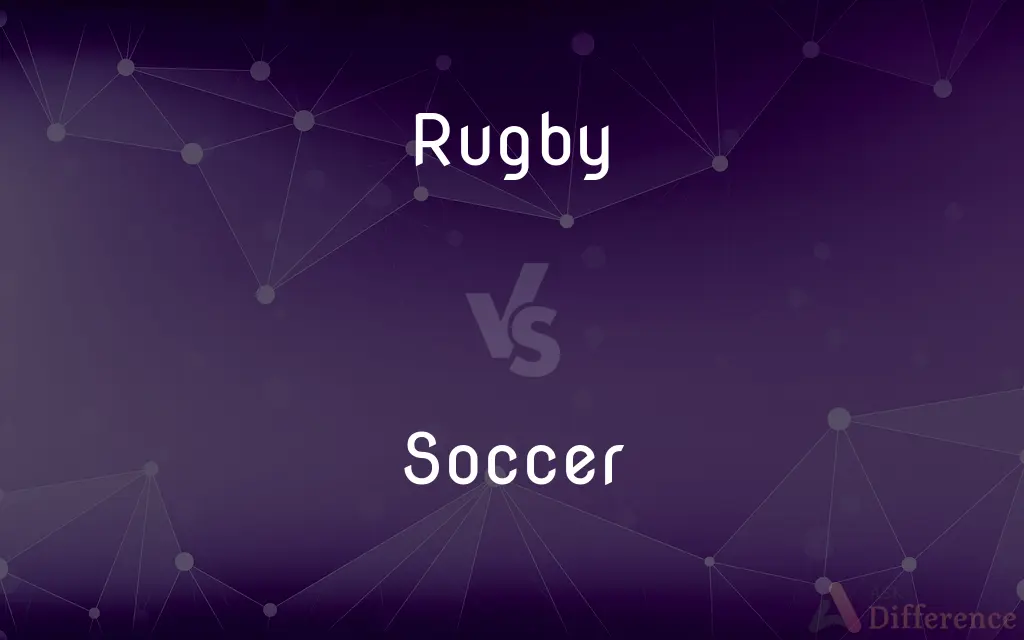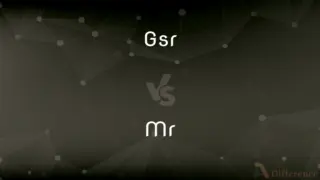Rugby vs. Soccer — What's the Difference?
By Tayyaba Rehman & Maham Liaqat — Updated on April 18, 2024
Rugby involves physical contact and tackling, with an oval ball and varied scoring methods; soccer focuses on foot skills, uses a round ball, and scores through goals only.

Difference Between Rugby and Soccer
Table of Contents
ADVERTISEMENT
Key Differences
Rugby is characterized by its allowance for physical contact such as tackling, rucking, and mauling, which are integral to gameplay. Whereas, soccer prohibits physical contact except for shoulder charges and slight body contact, emphasizing skill and strategy over brute strength.
In rugby, the ball used is oval and players can use their hands and feet to move the ball. On the other hand, soccer uses a spherical ball, and players (except the goalkeeper within their penalty area) must use their feet, head, or torso to play the ball.
Scoring in rugby can occur through tries, conversions, penalty kicks, and drop goals, offering multiple scoring opportunities with varying points. Conversely, soccer scores solely through goals, each uniformly worth one point, making every scoring opportunity crucial.
The rugby field, known as a pitch, typically measures up to 100 meters long and 70 meters wide, with H-shaped goalposts at each end. Soccer fields are generally larger, up to 120 meters long and 90 meters wide, with rectangular goals at the end lines.
Rugby matches consist of two halves, each lasting 40 minutes, with a short halftime. Soccer matches also consist of two 45-minute halves but feature added time for stoppages, and the clock does not stop like in rugby.
ADVERTISEMENT
Comparison Chart
Ball Shape
Oval
Round
Field Size
Up to 100m x 70m
Up to 120m x 90m
Scoring Methods
Tries, conversions, penalties, drop goals
Goals
Game Duration
80 minutes (2 x 40 min halves)
90 minutes plus stoppage time (2 x 45 min halves)
Physical Contact
Extensive (tackling, rucking)
Limited (mainly non-contact)
Compare with Definitions
Rugby
Rugby positions include forwards and backs, each with specific roles.
He played as a scrum-half, a crucial position in rugby for linking forwards and backs.
Soccer
Soccer positions include goalkeeper, defenders, midfielders, and forwards.
She played as a forward, always ready to attack the soccer field's goal.
Rugby
In rugby, scoring can be achieved by tries, conversions, or drop goals.
He scored a try in rugby by grounding the ball in the opponent's in-goal area.
Soccer
Matches consist of two 45-minute halves, often with additional injury time.
The soccer match went into extra time after a 2-2 tie at the end of regulation.
Rugby
Rugby games are divided into two halves, with a halftime break.
After the first half of rugby, the players regrouped for a strategic discussion.
Soccer
The sport strictly regulates the use of hands, reserving this for goalkeepers within their area.
In soccer, handling the ball is an offense unless you are the goalkeeper.
Rugby
The sport where the forward pass is illegal, and the ball carrier can be tackled.
In rugby, players pass the ball backwards to advance forward.
Soccer
A global team sport known for its minimal physical contact and use of a spherical ball.
Soccer is celebrated worldwide, with the FIFA World Cup being the pinnacle.
Rugby
A team sport played with an oval ball where physical contact is essential.
Rugby teams often practice scrummaging to enhance their tactical play.
Soccer
Scoring in soccer is done by sending the ball into the opposing team's goal.
The soccer player scored a goal from 30 yards out, stunning the crowd.
Rugby
A game played by two teams of 15 players each on a rectangular field 110 yards long with goal lines and goal posts at either end, the object being to run with an oval ball across the opponent's goal line or kick it through the upper portion of the goal posts, with forward passing and time-outs not permitted.
Soccer
A form of football played by two teams of eleven players with a round ball which may not be handled during play except by the goalkeepers.
Rugby
A form of football in which players can hold or kick an ovoid ball; rugby football. The ball cannot be handled forwards and points are scored by touching the ball to the ground in the area past the opponent's territory or by kicking the ball between goalposts and over a crossbar.
The scrum is a distinctive element of rugby.
The two rugbies split following a debate about amateurism.
Soccer
A game played on a rectangular field with net goals at either end in which two teams of 11 players each try to drive a ball into the other's goal by kicking, heading, or using any part of the body except the arms and hands. The goalie is the only player who may touch or move the ball with the arms or hands.
Rugby
(specifically) The form of the game known as rugby union (see the usage note).
Soccer
Indoor soccer.
Rugby
(countable) rugby shirt
Soccer
Association football.
Rugby
(Philippines) Rubber cement, contact cement.
Soccer
(Australian rules football) To kick the football directly off the ground, without using one's hands.
Rugby
(intransitive) To play rugby.
Soccer
A football game in which two teams of 11 players try to kick or head a ball into the opponents' goal
Rugby
A form of football played with an oval ball
Common Curiosities
How does the role of a referee differ between rugby and soccer?
In rugby, the referee is assisted by two touch judges and potentially a television match official (TMO), with a focus on safety and fair play in a physical game. In soccer, the referee is assisted by linesmen and a fourth official, focusing more on managing match flow and enforcing laws.
What is a scrum in rugby, and is there an equivalent in soccer?
A scrum is a method of restarting play in rugby involving players interlocking and competing for the ball. There is no direct equivalent in soccer, where play restarts are usually through set pieces like free kicks or throw-ins.
What types of protective gear are used in rugby that are not used in soccer?
Rugby players typically wear mouthguards, headgear, and sometimes padded clothing, whereas soccer players generally wear only shin guards.
Can rugby players be substituted as freely as soccer players?
No, rugby substitutions are limited and often for injury or tactical reasons, while soccer allows for tactical substitutions with a set number per match.
How are teams structured differently in rugby and soccer?
Rugby teams are split into forwards and backs, each with specialized roles, while soccer teams are organized into defenders, midfielders, forwards, and a goalkeeper.
How does the clock work in rugby compared to soccer?
In rugby, the clock stops for various reasons such as injuries or waiting for play to restart, whereas in soccer, the clock continues running, with additional time added at the end for stoppages.
How is fan culture different between rugby and soccer?
Rugby fans are known for mingling with opposing fans, often noted for their camaraderie. Soccer fan culture can be more intense, with a stronger emphasis on club loyalty and sometimes regional rivalries.
What is offside in rugby compared to soccer?
In rugby, a player is offside if they are in front of a teammate who last played the ball, unlike in soccer, where a player is offside if positioned closer to the opponent's goal line than both the ball and the second-last opponent when the ball is played to them.
What is a conversion in rugby?
A conversion in rugby is a kick at goal that follows a try, allowing the scoring team an opportunity to add two extra points.
What are the historical origins of rugby and soccer?
Both sports originated in England; rugby from Rugby School and soccer from various forms of folk football played in medieval Britain.
What happens when the ball goes out of play in rugby versus soccer?
In rugby, play restarts with a lineout or a scrum, depending on the situation. In soccer, play restarts with a throw-in, goal kick, or corner kick.
What is the significance of the number of players in rugby and soccer?
Rugby teams consist of 15 players in Rugby Union and 13 in Rugby League, reflecting the physical and strategic demands of the sport. Soccer teams always consist of 11 players, emphasizing stamina and spatial tactics.
How do the objectives of rugby and soccer fundamentally differ?
The fundamental objective in rugby is to carry or kick the ball into the opponent’s end zone to score points through various means, while in soccer, the primary objective is to score by getting the ball into the opponent's goal using mostly feet or head.
Are there different professional leagues in rugby like in soccer?
Yes, major rugby nations have professional leagues similar to soccer's domestic leagues, such as the English Premiership in rugby or La Liga in soccer.
How does international competition differ in rugby and soccer?
International rugby features tournaments like the Rugby World Cup and the Six Nations, while international soccer has the FIFA World Cup and continental championships like UEFA Euro.
Share Your Discovery

Previous Comparison
GSR vs. MR
Next Comparison
Diesel vs. PetrolAuthor Spotlight
Written by
Tayyaba RehmanTayyaba Rehman is a distinguished writer, currently serving as a primary contributor to askdifference.com. As a researcher in semantics and etymology, Tayyaba's passion for the complexity of languages and their distinctions has found a perfect home on the platform. Tayyaba delves into the intricacies of language, distinguishing between commonly confused words and phrases, thereby providing clarity for readers worldwide.
Co-written by
Maham Liaqat













































